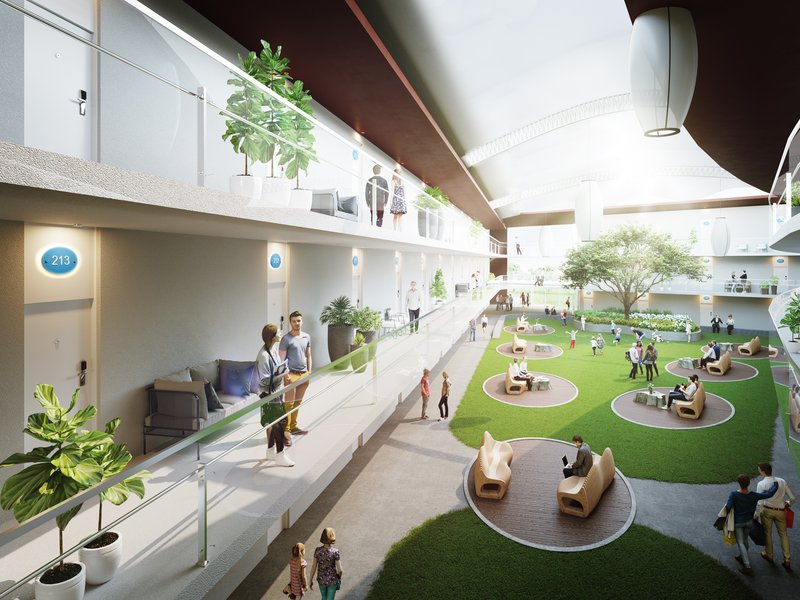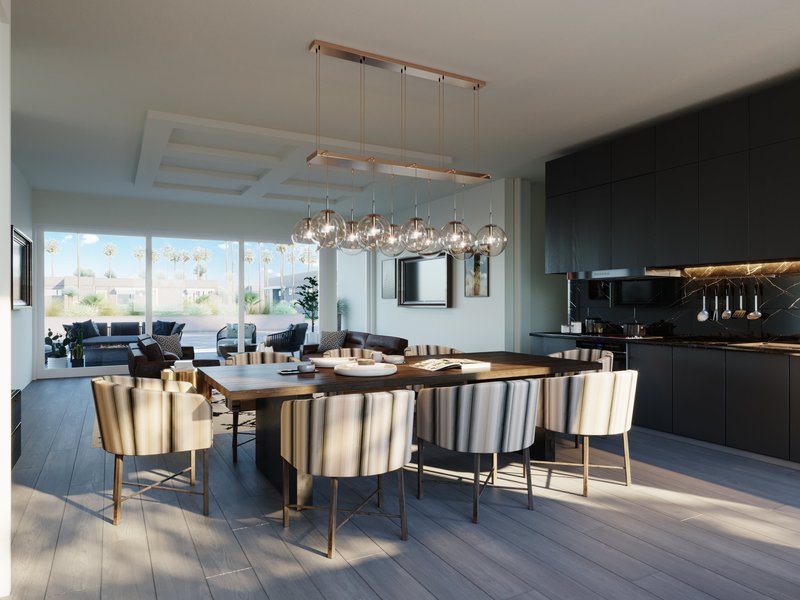The Importance of Architectural Rendering in Real Estate Marketing
In the world of real estate marketing, first impressions are crucial. Potential buyers and investors are often drawn to properties that capture their imagination and evoke a sense of possibility. This is where architectural rendering steps in, playing a pivotal role in captivating audiences and showcasing the true potential of a property.
In the world of real estate marketing, first impressions are crucial. Potential buyers and investors are often drawn to properties that capture their imagination and evoke a sense of possibility. This is where architectural rendering plays a pivotal role in captivating audiences and showcasing a property's true potential.
What is architectural rendering?
Architectural rendering refers to creating visually stunning and lifelike representations of architectural designs. Through the use of advanced computer software and technology, architectural rendering transforms architectural plans, blueprints, or 3D models into realistic images and immersive visual experiences. It brings the envisioned spaces to life, enabling clients, buyers, and investors to visualize and explore a property's aesthetics, design elements, and spatial qualities.
The significance of architectural rendering in real estate marketing

The significance of architectural rendering in real estate marketing cannot be overstated. It is a powerful tool enabling real estate professionals to communicate and market their properties effectively. By providing potential buyers and investors with visually interesting and accurate representations, architectural rendering helps bridge the gap between imagination and reality.
Architectural rendering holds the potential to create a lasting impact on the audience, evoking emotions and stirring aspirations. It allows viewers to envision themselves within the space, fostering a connection and emotional attachment to the property. It showcases design concepts, highlighting unique architectural features and selling points that set a property apart from others in the market.
Not only does architectural rendering enable interesting storytelling, but it also saves time and resources. With the ability to visualize and make informed decisions based on the rendered images, stakeholders can streamline the design and decision-making process, minimizing the need for costly physical models or prototypes. This speeds up the marketing and sales cycle and reduces the risk of errors and design changes.
Architectural rendering offers flexibility and versatility. It can be used across various platforms and media, including online listings, brochures, advertisements, and virtual tours. This widens the reach and impact of marketing efforts, attracting a larger audience and increasing the chances of successful sales.
As we delve deeper into the significance of architectural rendering in real estate marketing, we will explore its ability to pre-sell properties, foster collaboration, and facilitate customization. Through case studies and examples, we will witness how architectural rendering has become an essential and indispensable tool in the real estate industry.
1.) Visual Appeal and Emotional Connection
A. Creating visually interesting representations of properties
One of the primary objectives of architectural rendering in real estate marketing is to create visually stunning representations of properties. Architectural renderings transform two-dimensional designs into captivating three-dimensional visuals by employing advanced techniques such as realistic lighting, textures, and materials. These renderings bring the property to life, showcasing its potential in a way that traditional blueprints or flat images cannot achieve.
B. Evoking emotions and aspirations in potential buyers or investors
Architectural renderings have a remarkable ability to evoke emotions and aspirations in potential buyers or investors. By immersing viewers in a visually rich and immersive experience, renderings tap into their desires and ignite their imagination. The meticulous attention to detail, from the colour schemes to the carefully crafted ambiance, triggers a sense of excitement and possibility. Potential buyers can visualize themselves living, working, or investing in the property, making a deeper emotional connection.
C. Enhancing the marketing materials with realistic and captivating visuals
Architectural renderings are powerful assets that enhance marketing materials, making them more engaging and persuasive. They replace traditional, static images with dynamic and interactive visuals that captivate the audience's attention. High-quality renderings convey a sense of professionalism, showcasing the commitment to excellence and attention to detail of the real estate professionals involved. Whether incorporated into brochures, websites, or social media campaigns, architectural renderings elevate marketing materials to a new level, leaving a lasting impression on potential buyers and investors.
Realistic and captivating visuals offer a glimpse into the future, allowing viewers to see beyond the current state of the property. They showcase its potential, unique features, and ability to fulfil their aspirations and lifestyle preferences. Real estate professionals can create an interesting narrative through architectural rendering, presenting properties in the best possible light and enticing potential buyers or investors to take the next step.
2.) Showcasing Design Concepts and Features
A. Communicating the design intent and vision to clients
Architectural rendering serves as a powerful tool for effectively communicating the design intent and vision to clients. Through renderings, architects and designers can present their ideas in a visually engaging and accessible manner. They can showcase the layout, spatial relationships, and overall aesthetics of the property, enabling clients to fully grasp the proposed design. Renderings bring clarity and context to architectural plans, helping clients visualize how the space will look and feel once completed. This clear communication fosters trust and collaboration between the design professionals and their clients, leading to better project outcomes.
B. Highlighting unique architectural features and selling points
One of the key advantages of architectural rendering in real estate marketing is its ability to highlight the unique architectural features and selling points of a property. Whether it's an innovative facade design, a breathtaking view, or a standout interior feature, renderings can emphasize these aspects and make them visually impactful. By focusing on these distinctive elements, renderings attract the attention of potential buyers or investors, setting the property apart from others in the market. The ability to visually highlight these selling points helps create a powerful impression and generate interest, ultimately leading to a competitive edge in the real estate market.
C. Presenting various design options or configurations for buyer consideration
Architectural rendering also enables the presentation of various design options or configurations to potential buyers. Real estate professionals can provide buyers with a range of possibilities by creating multiple renderings showcasing different layouts, finishes, or interior design choices. This flexibility allows buyers to envision the property tailored to their preferences and lifestyle, increasing their emotional connection to the space. Whether it's offering options for room configurations, material selections, or design themes, renderings can guide buyers through the decision-making process, giving them a sense of ownership and personalization before the property is even constructed.
The ability to present design options through architectural rendering is valuable when customization is possible, such as pre-construction projects or properties undergoing renovations. Buyers can explore distinct possibilities and make informed decisions based on the rendered visuals, reducing the need for costly and time-consuming design revisions later on. This not only enhances the buyer's overall experience but also streamlines the sales process, accelerating decision-making and ultimately leading to higher satisfaction.
Through architectural rendering, real estate professionals can effectively communicate the design intent, highlight unique features, and present a range of design options to potential buyers or investors. By leveraging the power of visualization, renderings bring clarity, excitement, and personalization to the property, enhancing its marketability and desirability. In the next section, we will explore the time and cost savings that architectural rendering brings to the real estate industry.
3.) Time and Cost Savings
A. Reducing the need for physical models or prototypes
One of the significant advantages of architectural rendering in real estate marketing is its ability to reduce the reliance on physical models or prototypes. Traditionally, creating physical models to showcase a property's design and layout could be a time-consuming and costly process. Architectural rendering offers a cost-effective alternative by digitally creating highly realistic and detailed representations of the property. This eliminates the need for constructing physical models, saving both time and resources. Real estate professionals can now present their designs and ideas to clients and investors through high-quality renderings, providing a visually accurate and immersive experience without the limitations of physical models.
B. Minimizing design iterations and changes through visualization
Architectural rendering plays a crucial role in minimizing design iterations and changes, resulting in significant time and cost savings. With the ability to visualize and experience the property in a detailed and realistic manner, potential issues or design flaws can be identified early. Clients, architects, and designers can evaluate the rendered images and make informed decisions, addressing any necessary adjustments or modifications before construction or renovation begins. This proactive approach helps prevent costly revisions during the construction phase, saving both time and money. By reducing the number of design iterations, architectural rendering streamlines the entire project timeline and enhances project efficiency.
C. Saving time and money in the marketing and sales process
Architectural rendering offers substantial time and cost savings throughout the marketing and sales process. High-quality renderings serve as powerful marketing tools, enabling real estate professionals to showcase the property's potential to a wide audience with no physical showings. Prospective buyers can explore and evaluate the property through virtual tours or interactive presentations, eliminating the need for multiple on-site visits. This not only saves time for both the buyers and the real estate professionals but also reduces travel expenses and logistical challenges.
Architectural rendering speeds up the sales process by helping potential buyers make informed decisions more efficiently. The realistic visuals provided by renderings enable buyers to visualize themselves within the space, evaluate different design options, and assess the property's suitability for their needs. By providing a clear and immersive representation of the property, architectural rendering facilitates quicker decision-making and reduces the time spent on negotiations.
Architectural rendering contributes to cost savings by minimizing the need for extensive physical marketing materials, such as printed brochures or catalogues. Instead, digital renderings can be easily incorporated into websites, online listings, social media campaigns, and digital presentations, reaching a broader audience at a lower cost. This shift towards digital marketing materials not only reduces printing and distribution expenses but also allows for easy updates and revisions as needed.
4.) Marketing Versatility and Reach
A. Using architectural renders across multiple platforms and media
Architectural rendering offers tremendous marketing versatility by allowing real estate professionals to use the renders across multiple platforms and media. Whether it's for online listings, printed brochures, digital advertisements, or presentations, architectural renders can be seamlessly integrated into various marketing materials. The versatility of renderings enables consistent branding and messaging across different channels, creating a cohesive and interesting marketing campaign.
B. Leveraging renders for online listings, brochures, and advertisements
Online listings have become a primary source of property information for potential buyers and investors. Architectural renders play a vital role in enhancing online listings by providing eye-catching visuals that capture attention and differentiate the property from competitors. High-quality renderings showcase the property's unique features, allowing potential buyers to explore and envision the space before arranging a physical visit. Similarly, in printed brochures or advertisements, architectural renders serve as powerful visual tools that convey the property's essence and generate interest. Renderings offer a level of detail and realism that static images or floor plans simply cannot match, making them invaluable assets in marketing materials.
C. Expanding the reach to a wider audience through digital marketing channels
Digital marketing channels have revolutionized the way real estate is marketed, allowing for broader reach and engagement with potential buyers. Architectural renders excel in digital marketing campaigns, enabling real estate professionals to expand their reach to a wider audience. Renderings can be featured on websites, social media platforms, and targeted online advertisements, reaching potential buyers who may be in different geographic regions or have specific property preferences. The interactive nature of digital platforms also allows for engaging presentations and virtual tours, providing an immersive experience for viewers.
Architectural rendering opens up opportunities for augmented reality (AR) and virtual reality (VR) experiences. Potential buyers can use AR applications to overlay virtual furniture or decor onto rendered images, enabling them to envision the property with personalized elements. VR technology allows for immersive virtual tours, giving potential buyers a realistic sense of walking through the property from the comfort of their own homes. These innovative uses of architectural rendering and technology enhance the marketing reach and provide an interactive and engaging experience for potential buyers.
By leveraging architectural renders across multiple platforms and media, real estate professionals can effectively engage with a wider audience, create a consistent brand presence, and provide captivating visual experiences. The versatility of architectural rendering in marketing allows for greater impact and reach, ultimately increasing the chances of attracting potential buyers and closing successful sales.
5. Pre-Selling and Generating Interest
A. Pre-selling properties before completion or construction
Architectural rendering plays a crucial role in pre-selling properties before their completion or construction. By providing realistic and immersive visualizations of the future property, real estate professionals can generate interest and attract potential buyers or investors even before the project is completed. This early marketing strategy allows for a head start in the sales process, creating a buzz and anticipation around the property. Through architectural rendering, buyers can visualize the result and make purchasing decisions based on the rendered images, floor plans, and virtual tours.
B. Attracting potential buyers or investors with realistic visualizations
Architectural rendering serves as a powerful tool for attracting potential buyers or investors by providing them with realistic visualizations of the property. The detailed renderings showcase the property's exterior and interior design, highlighting its aesthetics, functionality, and potential. By presenting the property in its best light, architectural rendering captures the attention and imagination of potential buyers, enticing them to explore further and consider investing in the project. Realistic visualizations create a sense of trust and confidence, enabling potential buyers to envision themselves in the space and experience its appeal.
C. Building anticipation and excitement around upcoming projects
Architectural rendering helps to build anticipation and excitement around upcoming projects. By releasing captivating renderings, real estate professionals can generate a sense of curiosity and interest among potential buyers or investors. The detailed visuals allow them to envision the possibilities and imagine the lifestyle or business opportunities that the property can offer. This anticipation and excitement can lead to increased demand and a sense of urgency among potential buyers, driving the success of the project and enhancing its market value.
Architectural rendering enables real estate professionals to showcase the unique features and selling points of the property, creating a sense of exclusivity and desirability. Whether it's a luxury residential development, a commercial space with innovative design elements, or a mixed-use project with cutting-edge amenities, renderings effectively capture the essence of these features, generating interest and attracting potential buyers or investors who seek such unique opportunities.
Architectural rendering plays a pivotal role in pre-selling properties, attracting potential buyers or investors, and building anticipation and excitement around upcoming projects. Through realistic visualizations, architectural rendering allows buyers to see the potential of a property and make informed decisions. By leveraging the power of rendering, real estate professionals can generate interest, drive sales, and establish a strong market position even before the completion or construction of the property. As a result, architectural rendering serves as a strategic tool for successful pre-sales and generating substantial interest in the real estate market.
Conclusion
The importance of architectural rendering in real estate marketing cannot be overstated. Architectural rendering offers a multitude of benefits that significantly enhance the marketing and sales process, making it an indispensable tool for real estate professionals.
From its ability to create visually interesting representations of properties to evoking emotions and aspirations in potential buyers or investors, architectural rendering captures the attention and engages the audience on a deeper level. The realistic and captivating visuals provided by architectural rendering enhance the marketing materials, allowing potential buyers to immerse themselves in the property and make informed decisions.
Architectural rendering also serves as a powerful means of communicating design concepts and features to clients. It enables real estate professionals to convey the design intent and vision effectively, highlight unique architectural features, and present various design options for buyer consideration. This level of communication not only strengthens the client relationship but also streamlines the decision-making process, saving time and costs in the long run.
Architectural rendering offers substantial time and cost savings. By reducing the need for physical models or prototypes, minimizing design iterations through visualization, and streamlining the marketing and sales process, architectural rendering optimizes project efficiency and cost-effectiveness.
Architectural rendering provides marketing versatility and reach. It allows for the utilization of renders across multiple platforms and media, leveraging them for online listings, brochures, advertisements, and digital marketing campaigns. This versatility expands the reach to a wider audience, creating a consistent brand presence and generating greater interest in the property.
Architectural rendering offers flexibility for customization and personalization. Real estate professionals can tailor renders to specific target audiences or buyer preferences, customize them to match different architectural styles or interior designs, and allow buyers to visualize and personalize spaces before purchase. This level of customization enhances buyer engagement, fosters emotional connections, and increases the likelihood of successful sales.
Overall, architectural rendering is a vital component of real estate marketing. Its ability to create visually interesting representations, communicate design concepts, save time and costs, expand marketing reach, and facilitate customization and personalization make it an invaluable tool for real estate professionals. By embracing the power of architectural rendering, real estate professionals can enhance their marketing strategies, attract more potential buyers or investors, and achieve greater success in the competitive real estate market.
Our Services
View some of our most popular services below.














